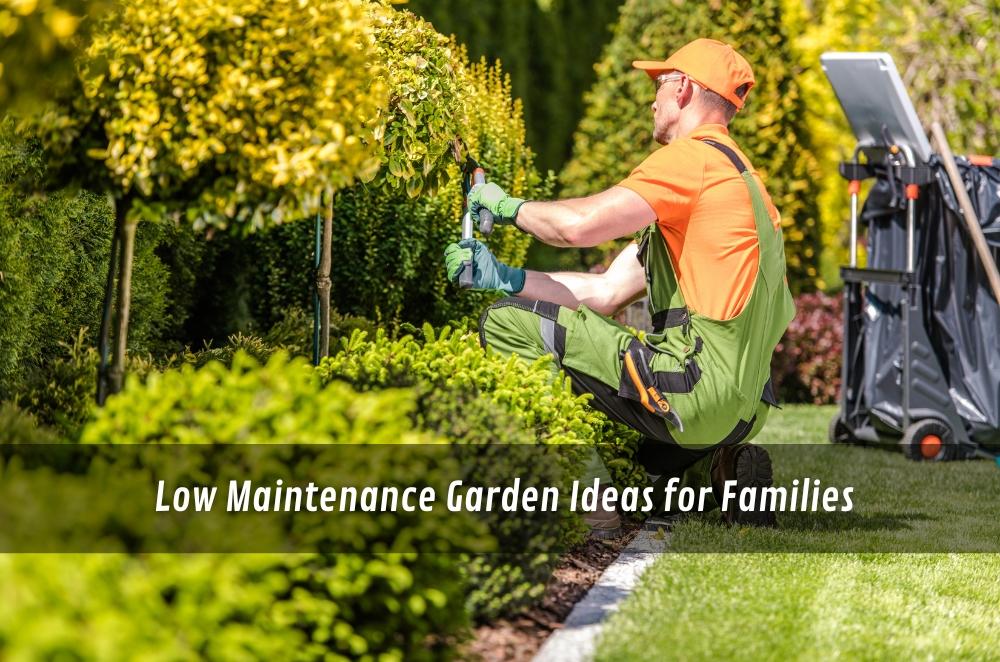Low Maintenance Garden Ideas for Families

Busy households need outdoor spaces that look good, survive school-holiday chaos, and don’t demand every weekend. The fastest way to get there is designing for fewer chores from day one. If you’re starting small, focus on layout, plant choice and water use — then, if you want help turning the plan into reality, explore low maintenance garden designs for small gardens for practical, budget-aware ideas that actually stick.
Start with the “maintenance map” (not the mood board)
Before choosing plants, map the work your garden creates:
-
Edges & boundaries: Long wiggly lawn edges = more trimming. Straighten runs or use steel/aluminium edging to keep grass where it belongs.
-
Access paths: Solid paths (steppers in gravel, pavers with joints) cut mud and mowing time.
-
Zones by use: Picnic, play, potting, bin access — each gets the surface that fits (lawn, mulch, gravel, pavers).
-
Irrigation reach: Design beds to match hose or drip lines. If it’s hard to water, it won’t get watered.
Tip: Any area you step on more than twice a week deserves a hard surface. It’ll save shoes and arguments.
The 3:2:1 planting formula (fast decisions, tidy beds)
For family gardens that look full without fuss:
-
3 structural plants (small trees or robust shrubs) for shape year-round
-
2 fillers (grasses or mid-shrubs) for texture and movement
-
1 groundcover to carpet soil and block weeds
Repeat the set across the bed. You’ll get rhythm without a plant encyclopedia — and winter won’t feel bare.
Water-wise by design (not afterthought)
A low-maintenance garden drinks less because it’s designed to. For practical guidance, see waterwise gardening for NSW-specific tips on watering, mulching and timing.
What works reliably:
-
Soil first: Add compost to planting holes and a soil wetter in hydrophobic sands.
-
Hydrozoning: Keep thirstier herbs/veg close to the tap; tougher natives further away.
-
Mulch blanket: 50–75 mm of coarse mulch locks moisture and blocks annual weeds.
-
Drip irrigation + timer: Target roots, not paths; set a dawn cycle and stop guessing.
Lawns that behave (or clever lawn alternatives)
If you love real turf:
-
Choose a shade-tolerant buffalo for mixed sun; keep mower blades sharp and height higher in summer.
-
Reduce lawn footprints to simple shapes; complex curves = edging time.
-
Add a kickabout strip only where it’s used; the rest can be groundcovers or steppers.
Lawn-lite ideas:
-
Native or ornamental grasses in drifts for soft borders.
-
Creeping groundcovers (between steppers) to green up without mowing.
-
A gravel courtyard with pots for colour — zero mowing, easy sweep.
Hard surfaces that save hours
-
Pavers with wide joints: weeds hate shade; fill with polymeric sand or compacted fines.
-
Gravel + steppers: fast to install, drains well, and repairs in minutes after kids’ games.
-
Concrete or exposed aggregate: set-and-forget for bins and bikes; add a strip drain where needed.
Pro move: keep materials to two or three finishes. Fewer materials = calmer look + fewer cleaning routines.
Plant picks that take care of themselves
Aim for species that handle heat, bounce back after a missed watering, and don’t shed mess daily. Think:
-
Small trees: Crepe myrtle (dwarf), tuckeroo (urban-tough), bay, olive (prune once a year).
-
Grasses/clumping: Lomandra, dianella, liriope — trim yearly, that’s it.
-
Shrubs: Westringia, rosemary, dwarf bottlebrush — light prune after flowering.
-
Groundcovers: Myoporum, native violet (shadier spots), creeping boobialla.
Want a deeper species list? Add a companion post on drought tolerant native plants.
Storage, mess control, and kid-proofing
-
Tool hooks & a small chest near the tap keep hoses, gloves and secateurs out of the weather.
-
Mulch pit or green bin corral tames the ugly zone.
-
Sandbox with a lid or a gravel dig zone concentrates play — and cleanup.
-
Edged veg beds (sleeper or steel) stop soil creeping onto paths.
My real-world tweaks that made weekends easier
1) The hose that saved Sundays
A family in Ryde watered with a kinked hose from the laundry. We ran a simple drip line with a battery timer, split into two zones. Result: fewer wilted afternoons, happier basil, and no more 6 pm sprints with a watering can.
2) The curve that doubled the mowing
A small Marrickville courtyard had a wavy lawn island. Pretty, but every mow required trimming both sides. We squared the lawn to a rectangle, added steppers around the edge, and cut mowing time by two-thirds. Looks cleaner; takes minutes.
Year-round chores (light, predictable, schedulable)
-
Autumn: Top up mulch; prune summer growth; check irrigation emitters.
-
Winter: Plant structural shrubs/trees; repair edging while growth is slow.
-
Spring: Feed (slow-release), set timers, check mower blades.
-
Summer: Deep water early; trim quick growers; sweep — not pressure wash — to protect grout/fines.
If you publish this on your site, link a practical checklist for low maintenance front garden ideas Australia so readers can adapt tasks to their climate.
Small-garden playbook (design moves that scale down)
-
Tall at the back, tidy at the front: layer heights so maintenance tools can reach.
-
Borrowed views: frame a neighbour’s jacaranda or sky slice; you’ll feel bigger than your lot size.
-
Mirrors or light-coloured walls: bounce daylight into narrow side yards.
-
Multipurpose furniture: storage bench by day, toy chest by night.
Budget wins that still look premium
-
One great feature (a dwarf tree in a pot or a corten edge) finishes the space more than five small items.
-
Pavers where feet go; gravel elsewhere — spend where it counts.
-
Divide and conquer: stage works (paths first, plants next, lighting later) to avoid re-doing anything.
Quick FAQs
Will gravel get everywhere?
Use a compacted road-base sublayer, edge the area, and choose a heavier grade. A quick rake resets footprints.
How much mulch is enough?
Aim for 50–75 mm. Too thin invites weeds; too thick suffocates stems.
Can I skip irrigation?
You can — with tough plants and small beds — but a simple drip on a timer turns “maintenance-lite” into “maintenance-minimal.”
Final thoughts
A family-friendly, low-maintenance garden isn’t about saying “no” to plants — it’s about saying “yes” to smarter structure. Keep edges clean, hardscape the high-traffic bits, choose resilient plants, and lock in water-wise habits early (the waterwise gardening checklist helps). If you decide to bring in pros, start with low maintenance garden designs for small gardens to align budget and layout — then enjoy weekends that look greener and feel lighter.







